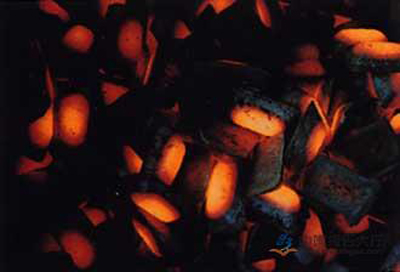
The research and analysis of cast iron industry market tells us that designing the appropriate diamond tools can satisfy the processing requirements of cast iron. Just like other application fields, diamond tools will change the unpleasant situation.

Diamond is not suitable for processing iron metal as the abrasive, which is based on the following aspects: Fe, Co, Ni and other Ⅷ family element metals are the solvent of carbon in the molten state. Therefore, the local high temperature of the cutting area will make carbon atoms of diamonds melt into metal lattice in the process of machining and diamond grits will lose the cutting edge and can't continue to work. At the same time, the processing of diamond tools for workpieces is based on the diamond grains on the working plane for cutting. Although these cutting blades are in great amount, the exposure is low. When grinding high strength, toughness, plastic metal materials, they are easy to jam and can not be used.
Though cast iron also belongs to the iron metal materials, it has different structure characteristics from ordinary steel. Cast iron is the iron carbon alloy with carbon content > 2.11% that is more than 2 times of steel. Besides white cast iron, the carbon of cast iron mainly exists in the form of free graphite. Therefore, the cast iron organization can be thought of as different shape, size, quantity of graphite on the substrate of steel structure. These characteristics of cast iron make the application of diamond tools possible.
First of all, the matrix organization with high carbon content and free graphite make cast iron high carbon concentration atmosphere around diamond cutting blade in the cutting process, whose atmosphere can slow the affinity and dissolving process between iron metal and diamond blade , and protect the diamond cutting edge from erosion; At the same time, the high content carbon in the matrix organization exists in the form of hard-brittle Fe3C, which reduces the toughness and plasticity index of matrix, and becomes more suitable for diamond blade machining.
Secondly, the existence of free graphite in cast iron makes its workability further improved: The graphite as a kind of soft non-metallic components, splits the continuity of the steel matrix structure, reduces the effective cross-sectional area of the load, and leads to stress concentration on the microscopic junction of graphite and steel structure, which all lower the strength and plastic index of cast iron, and make the chips produced by diamond cutting blade become brittle and broken, reducing the contact time between hot iron metal and diamond, reducing the thermal damage, and also preventing the chip blocking the cutting blade clearance. In addition, the fall-off of graphite on the grinding surface will form a tiny gap, and can decrease the temperature of grinding zone through the cooling liquid adsorption and storage.
The research and analysis of cast iron industry market tells us that designing the appropriate diamond tools can satisfy the processing requirements of cast iron. Just like other application fields, diamond tools will change the unpleasant situation.